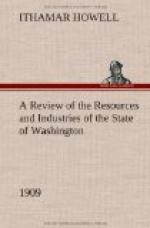The second district includes the territory lying between the Olympic and Cascade mountains, the chief physical feature of which is the great inland sea known as Puget Sound. The shore front of this important waterway exceeds 2,000 miles, and its length is broken by numerous bays and harbors, upon which are located Seattle, the state’s metropolis, and the growing cities of Tacoma, Everett, Bellingham and Olympia. The climate of this section is mild in winter and cool in summer, extremes in either season being practically unknown. Deep sea shipping enters the port of Puget Sound from every maritime country on the globe, and the industrial and commercial interests of this section are expanding with extraordinary rapidity.
The Cascade Mountains.
The Cascade mountains constitute the third of these natural divisions. This range extends in a broken line across the width of the state, at a distance of about 120 miles from the Pacific ocean. These mountains, their rugged peaks capped with a mantle of eternal snow, their sides covered with a heavy timber growth, and their valleys carrying numerous sparkling mountain streams, with illimitable possibilities for the development of power, are one of the important assets of the state, the value of which has not as yet even been estimated. The mineral wealth of the Cascades, only a slight knowledge of which has as yet been secured, will ere long contribute largely to the prosperity of the state, while the more moderate slopes of the mountains serve a valuable purpose for the pasturage of numerous flocks and herds.
Okanogan Highlands.
The fourth district is known as the Okanogan highlands, and occupies that portion of the state lying north of the Columbia river and east of the Cascade mountains. This section of the state contains valuable timber and mineral wealth in addition to presenting many attractive opportunities to the farmer and horticulturist. It has been hampered thus far by [Page 7] lack of adequate transportation facilities, and for this reason land may be had at exceptionally reasonable figures.
Columbia River Basin.
The Columbia river basin is by far the largest natural division of the state, and, generally speaking, includes the section drained by that river and its tributaries. Within the confines of this district are the great irrigated and grain-growing sections of the state, which are a source of constantly increasing wealth.
This great “Inland Empire,” as it has come to be called, has made thousands of homeseekers independent, and is largely responsible for the rise to commercial greatness of the splendid city of Spokane. Other cities of growing importance lying within the Columbia river basin are Walla Walla, North Yakima, Ellensburg and Wenatchee, while scores of smaller communities are annually adding to their population with the continued development of the districts of which they are the immediate distributing centers.




